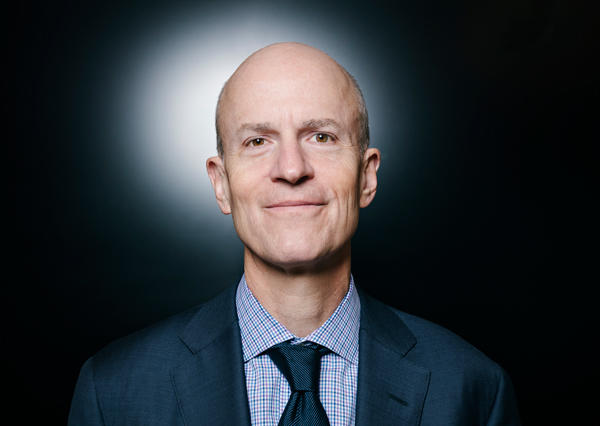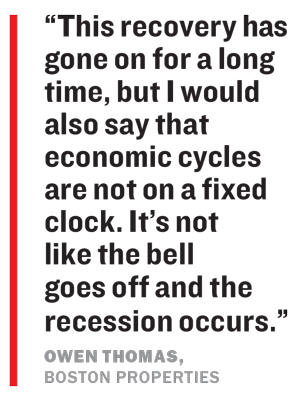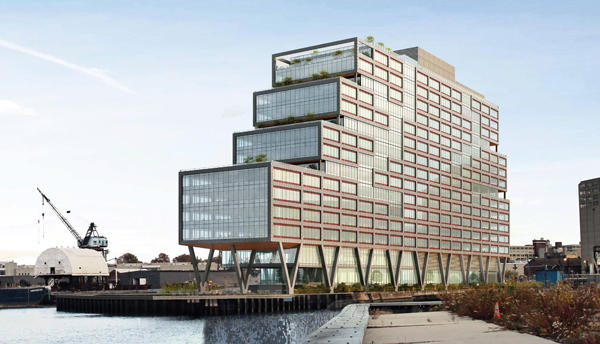Trending
Behind Boston Properties’ outside plays
The office REIT is betting big on co-working and ground-up development in new markets, but observers say the real test will be the next downturn

Boston Properties is riding high on Wall Street. But the success of some of its less tested plays in new development and shared office space could be riding on how much longer the economy grows.
For now, the real estate investment trust is beating out two of its top competitors on the stock market, Vornado and SL Green, and has $2.7 billion in new projects underway — almost entirely ground-up — that are nearly 80 percent preleased.
And, as the office landlord’s name boasts, it’s not just a New York story.
Boston Properties is staying ahead in the hypercompetitive REIT industry, sources say, largely because of its long-term investments in other cities. Among its five key markets, the firm of about 650 employees has major stakes in San Francisco and Boston, which give it a competitive edge with the ongoing tech and biotech booms in those cities.
“Those are markets that have a little more embedded growth than New York right now,” said Philip Kibel, an associate managing director in Moody’s real estate finance division, who pointed to rising rents and declining vacancy rates in both cities.
At the same time, the nearly 40-year-old firm still has a major presence in the Big Apple, with 27 office properties spanning just under 12 million square feet, including 767 Fifth Avenue, the Times Square Tower and 510 and 540 Madison Avenue.
Owen Thomas — who replaced Boston Properties’ co-founder Mort Zuckerman as CEO in 2013 — pointed to the REIT’s development projects, including Dock 72 in the Brooklyn Navy Yard, which are expected to start bringing in revenue soon.
“We have positioned the company for strong growth in 2019,” Thomas told The Real Deal in a recent interview in his firm’s New York office.
“If you look at our development pipeline, that’s been a substantial driver over the last few years,” he said, adding that the company’s growth forecast is likely “higher than all other office REITs and higher than most REITs, period.”
But Boston Properties’ aggressive bets on co-working and new office development in Brooklyn — both of which have yet to weather a significant downturn — carry a fair amount of risk, according to some observers. In the case of another big recession, which most economists say is simply a matter of when, less established lines of business could be among the hardest hit.
 Steven Marks, a managing director at Fitch Ratings, said that while the size and scope of Boston Properties’ exposure is manageable, “the co-working model — at least as it’s evolved and expanded this cycle — is untested in a recessionary period,” and “demand there could be more volatile.”
Steven Marks, a managing director at Fitch Ratings, said that while the size and scope of Boston Properties’ exposure is manageable, “the co-working model — at least as it’s evolved and expanded this cycle — is untested in a recessionary period,” and “demand there could be more volatile.”
The equity upswing
Following the stock market freefall late last year, Boston Properties’ share price has risen 25 percent since Jan. 1, trading at about $136 as of April 24. Within the past 12 months, the firm’s stock hit a high of nearly $140 and a low of just under $108 a share.
In the same period, Vornado was trading at half the value while SL Green was at nearly $90 a share, with a high of about $107 and a low of just under $77.
Boston Properties — which brought in $2.7 billion in revenue last year (on par with its development figures) — also has a higher growth estimate, at 9 percent, compared to 5 percent for Vornado and 3 percent for SL Green, according to financial services provider BMO Capital Markets.
Analysts pointed to several reasons why the REIT has been outperforming two of its major competitors. Moody’s, which gave Boston Properties a stable outlook in its latest report on the REIT, cited a diverse tenant base, strong liquidity and a high-quality office portfolio in several major markets.
But Alex Goldfarb, a senior REIT analyst at Sandler O’Neill & Partners, said Boston Properties is in a stronger position than Vornado and SL Green because its leadership team laid out a detailed growth strategy two years ago and has rigorously stuck to it. “They’re focused on growing the common dividend and growing earnings,” he said.
Goldfarb added that he’s also impressed by how self-sufficient the company has been in recent years. “They have not sourced external capital — equity capital — and yet they’re delivering on several billion [dollars] of projects,” he said, noting that the REIT has been able to self-fund through asset sales and that its last common equity raise was in 2010.
Kibel of Moody’s said any disruption to the company’s growth would likely have to come from a consequential downturn or another major market event.
Thomas said he expects a recession to hit at some point but doesn’t think it’s as imminent as others are forecasting. He added that his firm is well prepared for that because it’s not overleveraged and its existing portfolio is already about 90 percent leased, with average lease lengths running more than five years.
“This recovery has gone on for a long time, but I would also say that economic cycles are not on a fixed clock,” Thomas said. “It’s not like the bell goes off and the recession occurs.”
Big on Brooklyn
Boston Properties’ biggest ongoing project in New York is Dock 72 on the Brooklyn waterfront, its first Brooklyn property. The REIT is co-developing the 675,000-square-foot office building with Rudin Management and the We Company’s WeWork, which will also be the anchor tenant with a 220,000-square-foot lease.
Rudin Management’s Michael Rudin said the partnership came about because of a few chance encounters his father, Bill, had with Zuckerman at industry events. The two realized they were both interested in building an office property on the same site and began discussing a plan to work on it together.

Dock 72
The $400 million-plus project, which broke ground in 2016 and is scheduled to open before the fall, marks the first time Rudin Management has partnered with Boston Properties — or with any REIT, for that matter.
“It’s not the most natural or common partnership, but despite their structure [as a public company], they have a very long-term perspective on the business and on their assets,” Rudin noted. “That, for us, is very important, and it’s part of what made us comfortable proceeding with a deal.”
WeWork is the only lease at Dock 72 the companies are ready to announce so far, Rudin said. While the co-working giant has attracted its fair share of skeptics, he said he’s confident it will be a good anchor tenant for the building.
“People either love them or hate them and are fully bought in or not bought in at all,” Rudin said. “But we are firm believers that they bring value to a project and a property and will enhance the offering that we have at Dock 72.”
John Kim, a BMO Capital managing director, was more skeptical about the ground-up development, saying the Brooklyn Navy Yard is untested as an office market and lacks access to public transportation. He said the fact that WeWork is still Dock 72’s only announced tenant may be a sign that demand for space in the building is not that strong, which could prove to be an unusual situation for Boston Properties.
“Once it’s physically complete and WeWork moves in, maybe it gets some momentum after that,” Kim said. “But that’s been an outlier within their portfolio.”
Thomas maintained that plans for Dock 72 are proceeding smoothly and said the building’s large, open floors should help attract tech and media companies. Boston Properties is a big proponent of co-working and WeWork specifically, he added, calling the business model a perfect fit for large property owners that struggle to lease space to individuals and small companies.
“They aggregated that demand and then created more traditional leases for landlords like ourselves,” he said. “I think that’s been a big positive for the business.”
Boston Properties even launched its own co-working brand, called Flex by BXP, which now occupies a floor in Boston’s Prudential Center. The REIT hopes the new venture will give smaller tenants room to grow so they sign longer-term leases once they get big enough. If that effort proves fruitful, Flex could expand to other cities going forward, Thomas said.
Co-working aside, Craig Caggiano, executive director for the tri-state region at Colliers International, said he’s somewhat concerned about Brooklyn’s office market being oversaturated with new projects. Colliers teamed up with WeWork last year to help find tenants for Dock 72 but declined to comment on the project specifically.
Caggiano, however, said a big question looming over the Brooklyn office market as a whole is where is the “demand going to come from to fill this space?”
A recent Colliers report found that more than 7 million square feet of office space in the borough consists of ground-up or newly renovated construction expected to hit the market over the next three years. Other large office projects in the works on the west side of Brooklyn include Heritage Equity and Rubenstein Partners’ 25 Kent and JEMB Realty’s One Willoughby Square.
Franklin Wallach, a senior managing director in Colliers’ research group in New York, said most of that space should eventually get leased, but it could take a while with so much inventory coming to Brooklyn in such a short time span.
“It will get filled,” Wallach said of the ample supply of new buildings. “It’s just going to take time.”
Beyond New York
While Thomas and his associates are no strangers to the New York market, their biggest footprint, perhaps not surprisingly, is in Boston. Including the Prudential Center, where the firm is based, the REIT owns 46 office buildings in the city totaling more than 13 million square feet. It also has significant holdings in San Francisco, Los Angeles and Washington, D.C.
Vornado has long invested outside of New York as well, but that accounts for just 11 percent of its income today, compared to 73 percent for Boston Properties, per Moody’s.
In its latest note on Boston Properties, the ratings agency actually singled out New York as a weak spot, citing persistent “leasing challenges” with its Manhattan holdings and, to an extent, its office properties in D.C. Kibel said the firm’s rent increases in New York have been much weaker than the rest of its portfolio.
Thomas said the new supply of office space in Manhattan in recent years has put more pressure on rents. “If you go to Boston, San Francisco and Los Angeles, those markets have performed better,” he said. “Their rents are growing at a faster clip.”
The CEO added that financial and law firms were major growth engines prior to 2008, and while both industries are still vital to office leasing, he now sees more potential with tech, life sciences and co-working companies — which are less Manhattan-centric.
Eric Anton, an investment sales broker at Marcus & Millichap, singled out Boston and San Francisco as two prime markets for the firm to operate in these days, given the number of tech and biotech tenants in both cities. He said real estate owners that have invested in those two markets along with New York over the past five years are likely doing better than the ones that put all of their chips on New York.
Los Angeles, on the other hand, was more of a curious choice for Boston Properties, BMO Capital’s Kim said. The city, in general, suffers from limited opportunities to build new office space, due to strict zoning requirements, and the REIT’s initial entry into the area “raised some eyebrows,” he said.
“It was a new market for them in a very competitive environment and seemingly without the development potential,” Kim added. “Investors questioned how expensive it would be for Boston Properties to achieve scale in this market.”
But the REIT is in a better position in L.A. after teaming up with other investors to buy Colorado Center and Santa Monica Business Park from the Blackstone Group in 2016 and 2018 for $1.1 billion combined.
“The leasing has been successful, and there are some pretty significant redevelopment opportunities” with those properties, Kim said.
While expanding to other cities is not a priority in 2019, Thomas said, he and his colleagues always have an eye on new markets. He named Seattle as an intriguing possibility going forward.
“Most of the big tech companies all have pretty big positions in Seattle, so it’s a strong growth market from a demand standpoint,” he said. “The state of Washington has no income tax, at least for now. That’s probably a positive as well.”
Clarification: This story was updated to clarify that Colliers was discussing the Brooklyn office market in general, not Dock 72 specifically.




